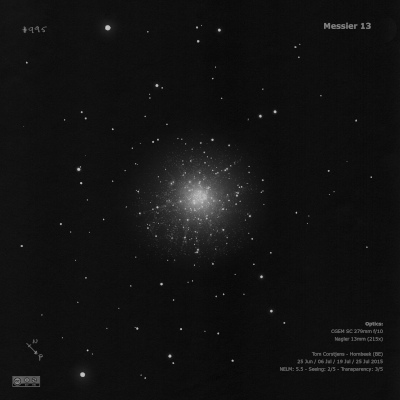Hercules Globular Cluster
Hercules Globular Cluster

Edmond Halley discovered M13 = NGC 6205 = h1968 in 1714 with a 24-foot (focal length) refractor. He noted "This is but a little Patch, but it shews itself to the naked eye, when the sky is serene and the Moon absent." Charles Messier independently found the cluster on 1 Jun 1764 and reported (first Messier catalogue), "I have discovered a nebula in the girdle of Hercules, of which I am sure it doesn't contain any star; having examined it with a Newtonian telescope of four feet and a half [FL], which magnified 60 times, it is round, beautiful & brilliant, the center brighter than the borders.."
M13 was probably the second deep-sky object that William Herschel observed (after the Orion Nebula) before starting his sweeps. Using a 6-inch (7-ft focal length) on 22 Aug 1779 he noted M13 was "without stars". On 16 May 1787 (sweep 739 with his 18.7-inch) he recorded, "a most beautiful cluster of stars, exceedingly compressed in the middle and very rich, the scattered stars which belong to it extend to 8 or 9' diam. The most compressed part about 2' or 2 1/2'; the later is R. The former more irregular."
William Parsons (LdR), in his 1850 monograph, noted "an unquestionable curvilinear sweep in the disposition of the exterior stars." Bond later "confirmed" this spiral structure (seems a case of imagining spiral arrangements in deep sky objects, which was common at the time) in 1860. Bindon Stoney sketch on 26 May 1851 (includied in the 1861 publication) clearly showed three dark "lanes"in a "Y" configuration. The dark lanes, sometimes referred to as the "propeller" nowadays, were mentioned in numerous observations with the 72". Mark Harrington, director of the Detroit Observatory in Ann Arbor, made a study of the dark rifts for a month in 1887 with the 6" and 12.5" refractors. Comparing Stoney's sketch with his observations and a drawing made with the aid of H.C. Markham, Harrington mistakenly concluded the rifts "have shifted their position slightly" since Stoney's drawing.
200/250mm - 8" very bright, very large, round, highly resolved into several hundred stars mag 11.5-13.5 over the entire disc. Includes several star chains and streamers.
400/500mm - 17.5" (7/9/94): several hundred stars in a 10'-12' diameter with a bright central core of 6' diameter. Many stars are arranged in strings and loops including a distinctive streamer attached on the SE side which heads south and curves west forming a semicircle and another string is attached on the west side of the core and precedes the cluster. Several chains of stars are also resolved over the 6' core. Running along the north edge of the core is a starless strip or a long dark lane which separates the central region from the northern outer halo members. A dark "lane" protrudes into the core on the SE side - this is one of three dark lanes that converge forming a "Y" and referred to as the "Propeller" (first described by Lord Rosse). NGC 6207 lies 28' NE and extremely faint IC 4617 lies 14' NNE. HD 150998, a mag 6.8 orange K2 star, lies 17' ENE of center.
Naked-eye - fairly easy object in a dark sky, appearing as a dim bloated star.
Notes by Steve Gottlieb